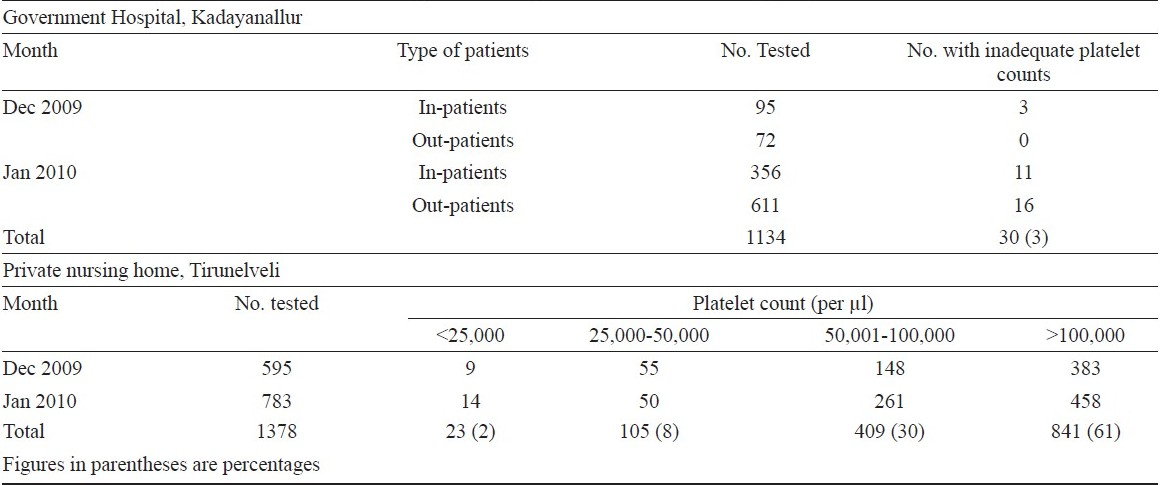Translate this page into:
Treatment practices & laboratory investigations during Chikungunya outbreaks in South India
*For correspondence: mmurhekar@gmail.com
This is an open-access article distributed under the terms of the Creative Commons Attribution-Noncommercial-Share Alike 3.0 Unported, which permits unrestricted use, distribution, and reproduction in any medium, provided the original work is properly cited.
This article was originally published by Medknow Publications and was migrated to Scientific Scholar after the change of Publisher.
Sir,
After the re-emergence of chikungunya fever during 2005, widespread outbreaks were reported from several Indian States affecting more than 175,000 individuals12. Laboratory investigations during these outbreaks were mainly to confirm the aetiology as these tests have a limited role in case management. The treatment for the disease mainly includes symptomatic management of joint pain with non-steroidal anti-inflammatory drugs. However, as the joint pain lasts for a long period of time, medications for the treatment of chikungunya are likely to be overused. During the outbreaks, co-circulation of chikungunya and dengue viruses is likely because of their common mosquito vectors3. As a result, some chikungunya patients are likely to be investigated for platelet counts, an investigation commonly done in dengue patients. We investigated two chikungunya outbreaks, one during 2006 in Andhra Pradesh4and other in Tamil Nadu in 2009. The objective was to summarize the findings from both the investigations in terms of the treatment practices and laboratory investigations conducted.
Treatment practices during the chikungunya outbreak, Mallela village, Kadapa district, Andhra Pradesh, 2006: On door-to-door search in the village, 242 patients (attack rate: 12%) were identified with acute onset of febrile illness and joint pain. Sixty seven per cent of the 134 patients had IgM antibodies against Chikungunya4. All patients were interviewed to get information about their illness and treatment received.
All 242 patients received treatment for a median of 10 days (Range: 0-110 days) from primary health care facilities (n=123, 51%) or “medical camps” organized for case-finding and treatment (n=73, 30%) or unqualified health providers (n=116, 48%). Many patients received antibiotics (n=97, 40%) or injections (probably analgesic though patients were not able to tell name of the medicine used in the injection; n=227, 94%). Among those who received injection (median number received: 8, Range: 1-150), 127 (56%) received it from an informal, unqualified health provider and 216 (95%) received it with a new disposable syringe. The median out-of-pocket expenses among patients was 550 Indian rupees (Range: 0-15,000  ) for the course of the illness.
) for the course of the illness.
Laboratory investigations during the chikungunya outbreak in Tirunelveli district, Tamil Nadu, 2009-2010: The outbreak occurred in Melapalayam and Kadayanallur municipality areas during December 2009-January 2010. Sixteen of the 31 serum samples collected from patients were positive for IgM antibodies against chikungunya. To know the laboratory investigations conducted for case management, data on platelet counts for fever patients attending a State government hospital doing the platelet count and one of the largest private hospitals in the district were analysed and the physicians treating the patients and laboratory technicians in the two hospitals were interviewed.
During December 2009-January 2010, platelet counts were estimated for more than 2500 patients with fever attending the two selected hospitals. In the private hospital, the platelets were counted using automated cell counter. If the counts were found to be low, number of platelets were counted per oil immersion field and reported. In the government hospital, as there was no automated counter, number of platelets in the peripheral blood smear were counted and reported as adequate, if the count ranged between 5-25 per field and inadequate for counts less than five. Less than 3 per cent of the total cases investigated at the government hospital had inadequate counts while 2 per cent of the cases investigated at the private hospital had counts below 25,000 (Table). None of these patients had any bleeding manifestations.

Chikungunya outbreaks, in addition to the burden associated with illness, led to unnecessary use of health care resources that were costly to patients. In Kadapa district, medicines were overused while in Tirunelveli, a large number of patients were investigated for thrombocytopenia. During the initial phase of the outbreak in Tirunelveli, the physicians advised platelet counts for the fever patients as the aetiology of the disease was unknown. Limited data are available about the treatment practices and laboratory investigations during other outbreaks that occurred in India. However, treatment and investigation practices observed during the outbreaks in Kadapa and Tirunelveli are likely to be similar to chikungunya outbreaks that occurred in other parts of country. In order to prevent such practices during future outbreaks, it is necessary to educate the health professionals to restrict the treatment to oral analgesics and abstain from irrational use of antibiotics and injections and avoid unnecessary laboratory investigations. Secondly the patients need to be educated about the self-limiting nature of the illness.
References
- Chikungunya outbreaks caused by African genotype, India. Emerg Infect Dis. 2006;12:1580-3.
- [Google Scholar]
- National Vector Borne Disease Control Programme, Directorate General of Health Services, Ministry of Health and Family Welfare, Government of India, New Delhi. Available from: http://nvbdcp.gov.in/Doc/chikun-update07.pdf
- [Google Scholar]
- Concurrent chikungunya and dengue virus infections during simultaneous outbreaks, Gabon, 2007. Emerg Infect Dis. 2009;15:591-3.
- [Google Scholar]





